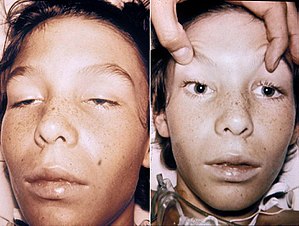Infant botulism
| Botulism | |
|---|---|
 |
|
| A 14-year-old with botulism. Note the weakness of his eye muscles and the drooping eyelids in the adjacent image, and the large and non moving pupils in the right image. This youth was fully conscious. | |
| Pronunciation | |
| Classification and external resources | |
| Specialty | Infectious disease, Gastroenterology |
| ICD-10 | A05.1 |
| ICD-9-CM | 005.1,040.41,040.42 |
| DiseasesDB | 2811 |
| MedlinePlus | 000598 |
| eMedicine | article/213311 |
| Patient UK | Botulism |
| MeSH | D001906 |
Botulism is a rare and potentially fatal illness caused by a toxin, produced by the bacterium Clostridium botulinum. The disease begins with weakness, trouble seeing, feeling tired, and trouble speaking. This may then be followed by weakness of the arms, chest muscles, and legs. The disease does not usually affect consciousness or cause a fever.
Botulism can be spread several different ways. The bacterial spores which cause it are common in both soil and water. They produce the botulinum toxin when exposed to low oxygen levels and certain temperatures. Foodborne botulism happens when food containing the toxin is eaten. Infant botulism happens when the bacteria develops in the intestines and releases the toxin. This typically only occurs in children less than six months old, as protective mechanisms develop after that time. Wound botulism is found most often among those who inject street drugs. In this situation, spores enter a wound, and in the absence of oxygen, release the toxin. It is not passed directly between people. The diagnosis is confirmed by finding the toxin or bacteria in the person in question.
Prevention is primarily by proper food preparation. The toxin, though not the organism, is destroyed by heating it to more than 85 °C (185 °F) for longer than 5 minutes. Honey can contain the organism, and for this reason, honey should not be fed to children under 12 months. Treatment is with an antitoxin. In those who lose their ability to breathe on their own, mechanical ventilation may be necessary for months. Antibiotics may be used for wound botulism. Death occurs in 5 to 10% of people. Botulism also affects many other animals. The word is from Latin, botulus, meaning sausage. Early descriptions of botulism date from at least as far back as 1793 in Germany.
The muscle weakness of botulism characteristically starts in the muscles supplied by the cranial nerves—a group of twelve nerves that control eye movements, the facial muscles and the muscles controlling chewing and swallowing. Double vision, drooping of both eyelids, loss of facial expression and swallowing problems may therefore occur. In addition to affecting the voluntary muscles, it can also cause disruptions in the autonomic nervous system. This is experienced as a dry mouth and throat (due to decreased production of saliva), postural hypotension (decreased blood pressure on standing, with resultant lightheadedness and risk of blackouts), and eventually constipation (due to decreased peristalsis). Some of the toxins (B and E) also precipitate nausea, vomiting, and difficulty with talking. The weakness then spreads to the arms (starting in the shoulders and proceeding to the forearms) and legs (again from the thighs down to the feet).
...
Wikipedia
